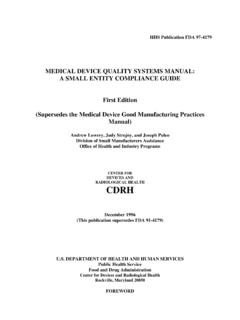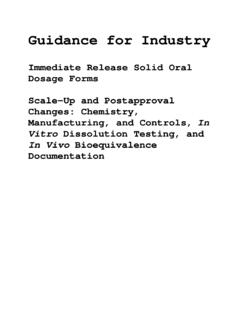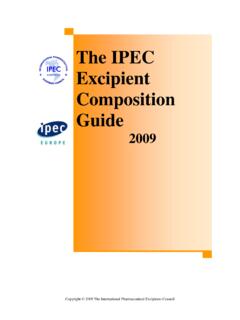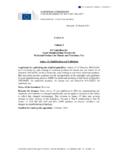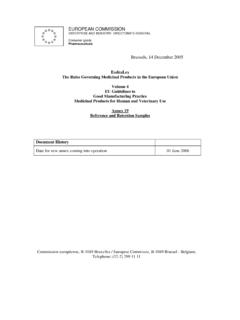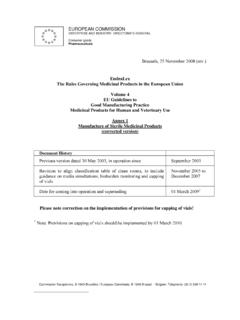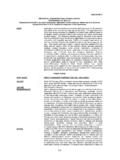Transcription of GMP Guide Chapter 1 Q10 implementation final
1 Ref. Ares(2012)778531 - 28/06/2012. EUROPEAN COMMISSION. HEALTH AND CONSUMERS DIRECTORATE-GENERAL. Health Systems and Products Medicinal Products - Quality, safety and efficacy Brussels, SANCO/AM/ (2012)860362. EudraLex The Rules Governing Medicinal Products in the European Union Volume 4. EU Guidelines for Good manufacturing Practice for Medicinal Products for Human and Veterinary Use Chapter 1. Pharmaceutical Quality System Legal basis for publishing the detailed guidelines: Article 47 of Directive 2001/83/EC on the Community code relating to medicinal products for human use and Article 51 of Directive 2001/82/EC on the Community code relating to veterinary medicinal products.
2 This document provides guidance for the interpretation of the principles and guidelines of good manufacturing practice (GMP) for medicinal products as laid down in Directive 2003/94/EC for medicinal products for human use and Directive 91/412/EEC for veterinary use. Status of the document: revision 3. Reasons for changes: Amendments to the text of Chapter 1 have been made in order to align with the concepts and terminology described in the ICH Q10 tripartite guideline on Pharmaceutical Quality System. The title of the Chapter itself is also changed accordingly. Deadline for coming into operation: 31 January 2013.
3 Commission Europ enne, B-1049 Bruxelles / Europese Commissie, B-1049 Brussel Belgium. Telephone: (32-2) 299 11 11. 1. Principle The holder of a manufacturing Authorisation must manufacture medicinal products so as to ensure that they are fit for their intended use, comply with the requirements of the Marketing Authorisation or Clinical Trial Authorisation, as appropriate and do not place patients at risk due to inadequate safety, quality or efficacy. The attainment of this quality objective is the responsibility of senior management and requires the participation and commitment by staff in many different departments and at all levels within the company, by the company's suppliers and by its distributors.
4 To achieve this quality objective reliably there must be a comprehensively designed and correctly implemented Pharmaceutical Quality System1 incorporating Good manufacturing Practice and Quality Risk Management. It should be fully documented and its effectiveness monitored. All parts of the Pharmaceutical Quality System should be adequately resourced with competent personnel, and suitable and sufficient premises, equipment and facilities. There are additional legal responsibilities for the holder of the manufacturing Authorisation and for the Qualified Person(s). The basic concepts of Quality Management, Good manufacturing Practice and Quality Risk Management are inter-related.
5 They are described here in order to emphasise their relationships and their fundamental importance to the production and control of medicinal products. Pharmaceutical Quality System1. Quality Management is a wide-ranging concept, which covers all matters, which individually or collectively influence the quality of a product. It is the sum total of the organised arrangements made with the objective of ensuring that medicinal products are of the quality required for their intended use. Quality Management therefore incorporates Good manufacturing Practice. GMP applies to the lifecycle stages from the manufacture of investigational medicinal products, technology transfer, commercial manufacturing through to product discontinuation.
6 However the Pharmaceutical Quality System can extend to the pharmaceutical development lifecycle stage as described in ICH Q10, which while optional, should facilitate innovation and continual improvement and strengthen the link between pharmaceutical development and manufacturing activities. ICH Q10 is reproduced in Part III of the Guide and can be used to supplement the contents of this Chapter . The size and complexity of the company's activities should be taken into consideration when developing a new Pharmaceutical Quality System or modifying an existing one. The design of the system should incorporate appropriate risk management principles including the use of appropriate tools.
7 While some aspects of the system can be company-wide and others site-specific, the effectiveness of the system is normally demonstrated at the site level. 1. Art 6 of Directives 2003/94/EC and 91/412/EEC require manufacturers to establish and implement an effective pharmaceutical quality assurance system. The term Pharmaceutical Quality System is used in this Chapter in the interests of consistency with ICH Q10 terminology. For the purposes of this Chapter these terms can be considered interchangeable. 2. A Pharmaceutical Quality System appropriate for the manufacture of medicinal products should ensure that: (i) Product realisation is achieved by designing, planning, implementing, maintaining and continuously improving a system that allows the consistent delivery of products with appropriate quality attributes.
8 (ii) Product and process knowledge is managed throughout all lifecycle stages;. (iii) Medicinal products are designed and developed in a way that takes account of the requirements of Good manufacturing Practice;. (iv) Production and control operations are clearly specified and Good manufacturing Practice adopted;. (v) Managerial responsibilities are clearly specified;. (vi) Arrangements are made for the manufacture, supply and use of the correct starting and packaging materials, the selection and monitoring of suppliers and for verifying that each delivery is from the approved supply chain;. (vii) Processes are in place to assure the management of outsourced activities.
9 (viii) A state of control is established and maintained by developing and using effective monitoring and control systems for process performance and product quality. (ix) The results of product and processes monitoring are taken into account in batch release, in the investigation of deviations, and, with a view to taking preventive action to avoid potential deviations occurring in the future. (x) All necessary controls on intermediate products, and any other in-process controls and validations are carried out;. (xii) Continual improvement is facilitated through the implementation of quality improvements appropriate to the current level of process and product knowledge.
10 (xiii) Arrangements are in place for the prospective evaluation of planned changes and their approval prior to implementation taking into account regulatory notification and approval where required;. (xiv) After implementation of any change, an evaluation is undertaken to confirm the quality objectives were achieved and that there was no unintended deleterious impact on product quality;. (xv) An appropriate level of root cause analysis should be applied during the investigation of deviations, suspected product defects and other problems. This can be determined using Quality Risk Management principles. In cases 3.
